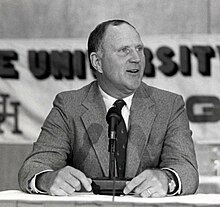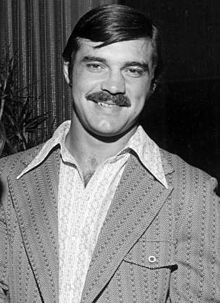World Football League
Although the league's proclaimed ambition was to bring American football onto a worldwide stage, only one team – the Hawaiians in Honolulu, Hawaii - was headquartered outside of continental North America.
At a press conference held in Chicago on October 2, 1973, Davidson announced his core of investors, a group of men he called the "founding fathers".
The younger Bassett had been mulling over starting his own professional football league when he happened to meet Davidson and he was given a franchise for Toronto.
Along with the original founding fathers, the rest of the owners soon fell into place, including a man whose own dreams of playing football were ended by a heart ailment, Thomas Origer, who later ran the Chicago Fire.
With the uncertain labor situation, the WFL had the opportunity to provide players with a better deal than the established leagues would give them, along with the promise of employment.
Davidson's league garnered major publicity when the Toronto Northmen, led by John F. Bassett, signed three Miami Dolphins players, fullback Larry Csonka,[1] halfback Jim Kiick, and wide receiver Paul Warfield[4] to what was then the richest three-player deal in sports, an astounding US$3.5 million to start in 1975.
Ken Stabler[1] signed with the Birmingham Americans, and Daryle Lamonica penned a contract to play for the Southern California Sun starting in 1975.
The Dallas Cowboys also took roster hits when WFL teams in Hawaii and Houston signed running back Calvin Hill and quarterback Craig Morton respectively.
David Jaynes, quarterback from Kansas, was the first player selected in the draft by the original Memphis franchise that became the Houston Texans by the time the season started.
Most notably, Bassett's Toronto Northmen were forced to find a new home after the Canadian government threatened to ban any American football team from competing with the CFL.
The WFL suffered an even more serious blow when the CFL and NFL reached agreements with their striking players that ensured that the upstart league would be forced to compete with both of their established rivals.
The box office numbers proved to be the beginning of the WFL's undoing when two teams admitted to inflating their gates on a scale virtually unprecedented in major league sports.
On top of this, the Wheels moved one game to London, Ontario due to poor ticket sales, this time without any complaints from Canadian officials.
The Hornets had their uniforms impounded for not paying a laundry bill from the time the team was located in New York and were not paid regularly after the third week in October.
One player was forced to pay a hospital bill for his son out of pocket after being informed the team's insurance policy had been cancelled for non-payment of premiums.
Rather than endure the embarrassment of media sneers about whether a WFL check would clear, the league neatly stacked $10,000 in cash high upon a table in the middle of the field.
Both teams were owed several weeks' back pay; the Americans only agreed to play when their owner promised them championship rings if they won.
Home-grown talent, like quarterbacks Tony Adams, Danny White, and wideout Alfred Jenkins quickly bolted for the NFL, with Adams landing with the Kansas City Chiefs, White with the Dallas Cowboys, and Jenkins with the Atlanta Falcons; Florida head coach Jack Pardee also got star Blazers' tight end Greg Latta to jump ship with him to the NFL's Bears.
During the offseason, Hemmeter developed a plan to restore a measure of financial sanity to the league by paying players and coaches based on a percentage of revenues, while imposing strict capitalization requirements on the teams.
The Winds invested considerable money and time in the effort to sign Namath (the team even designed its uniform to emulate the Jets'), and all but promised he was coming to Chicago.
Despite Hemmeter's efforts, several teams soon ran into financial difficulties, in part due to alarmingly low attendance figures.
[20] The WFL, for all its embarrassing miscues, produced a number of coaches who found success in the NFL, notably Jack Pardee, Lindy Infante, and Marty Schottenheimer.
McVay worked his way up the Giants organization and eventually became the team's head coach; he had even more success as general manager of the San Francisco 49ers during the 1980s dynasty years.
Several players, most notably Pat Haden, Danny White, Alfred Jenkins, Greg Latta, and Vince Papale, later found success in the NFL as well.
The league's most severe impact was on the Miami Dolphins, who had just won consecutive Super Bowls before the WFL's snagging of three of their star players.
Its arrival resulted in the end of the ACFL and SFL, effectively killing minor-league professional football in the United States until the AFA's formation in 1979.
New York's midseason relocation came in part because the lights at Downing Stadium were nowhere near bright enough to illuminate the entire field, leading TVS to deem them inadequate for broadcast.
By the time of the World Bowl, the games were struggling to achieve Nielsen ratings above 2.0, and TVS found it nearly impossible to sell advertising.
"[28] Twenty-one minutes of the TVS broadcast of the 1974 World Bowl - including the pre-game show, player introductions, and opening kick off - was uploaded to YouTube in 2018.
At the time, the AFL–NFL merger, coupled with the launch of Monday Night Football, had spread the NFL broadcast rights over all three of the Big Three television networks.




